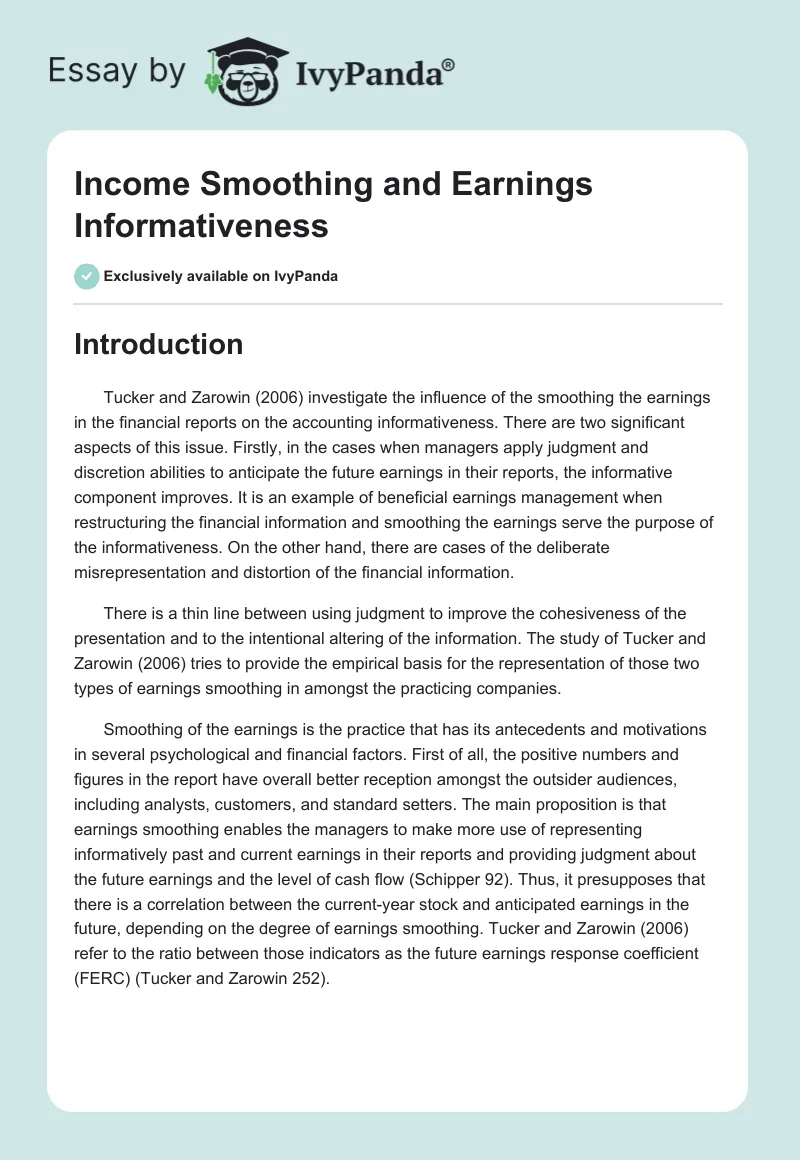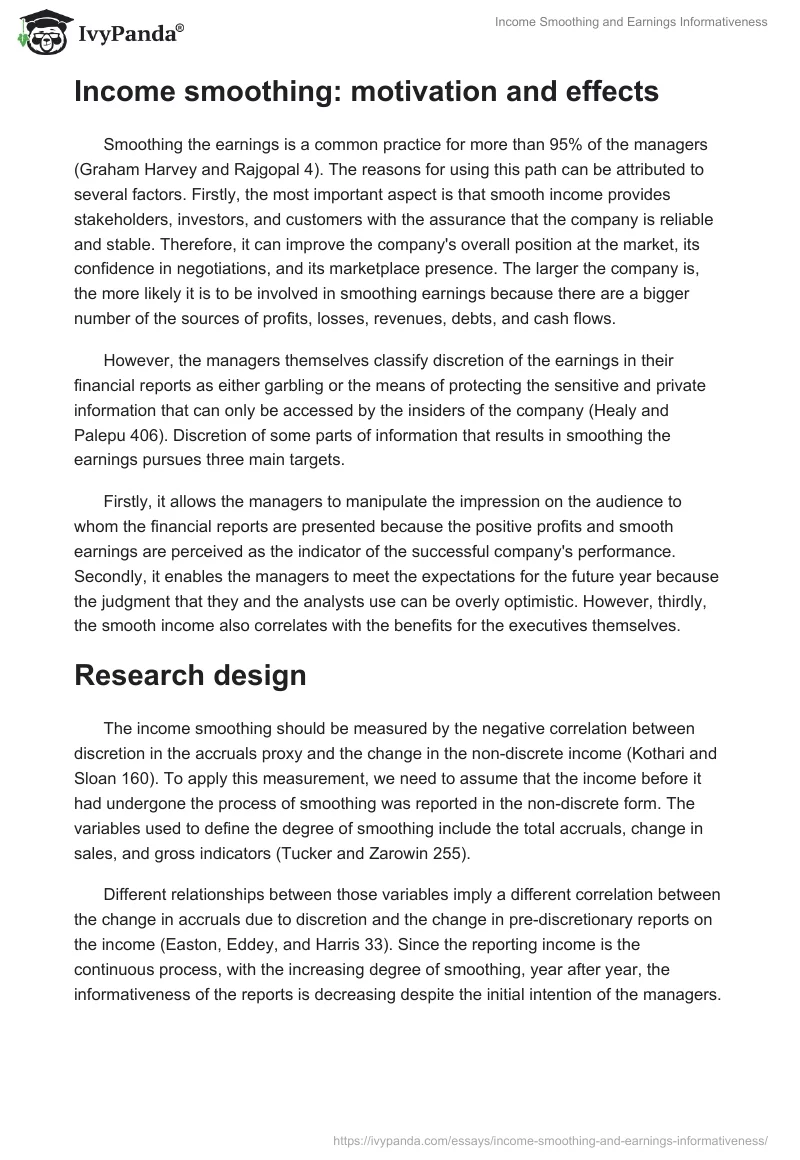Introduction
Tucker and Zarowin (2006) investigate the influence of the smoothing the earnings in the financial reports on the accounting informativeness. There are two significant aspects of this issue. Firstly, in the cases when managers apply judgment and discretion abilities to anticipate the future earnings in their reports, the informative component improves. It is an example of beneficial earnings management when restructuring the financial information and smoothing the earnings serve the purpose of the informativeness. On the other hand, there are cases of the deliberate misrepresentation and distortion of the financial information.
There is a thin line between using judgment to improve the cohesiveness of the presentation and to the intentional altering of the information. The study of Tucker and Zarowin (2006) tries to provide the empirical basis for the representation of those two types of earnings smoothing in amongst the practicing companies.
Smoothing of the earnings is the practice that has its antecedents and motivations in several psychological and financial factors. First of all, the positive numbers and figures in the report have overall better reception amongst the outsider audiences, including analysts, customers, and standard setters. The main proposition is that earnings smoothing enables the managers to make more use of representing informatively past and current earnings in their reports and providing judgment about the future earnings and the level of cash flow (Schipper 92). Thus, it presupposes that there is a correlation between the current-year stock and anticipated earnings in the future, depending on the degree of earnings smoothing. Tucker and Zarowin (2006) refer to the ratio between those indicators as the future earnings response coefficient (FERC) (Tucker and Zarowin 252).
Income smoothing: motivation and effects
Smoothing the earnings is a common practice for more than 95% of the managers (Graham Harvey and Rajgopal 4). The reasons for using this path can be attributed to several factors. Firstly, the most important aspect is that smooth income provides stakeholders, investors, and customers with the assurance that the company is reliable and stable. Therefore, it can improve the company’s overall position at the market, its confidence in negotiations, and its marketplace presence. The larger the company is, the more likely it is to be involved in smoothing earnings because there are a bigger number of the sources of profits, losses, revenues, debts, and cash flows.
However, the managers themselves classify discretion of the earnings in their financial reports as either garbling or the means of protecting the sensitive and private information that can only be accessed by the insiders of the company (Healy and Palepu 406). Discretion of some parts of information that results in smoothing the earnings pursues three main targets.
Firstly, it allows the managers to manipulate the impression on the audience to whom the financial reports are presented because the positive profits and smooth earnings are perceived as the indicator of the successful company’s performance. Secondly, it enables the managers to meet the expectations for the future year because the judgment that they and the analysts use can be overly optimistic. However, thirdly, the smooth income also correlates with the benefits for the executives themselves.
Research design
The income smoothing should be measured by the negative correlation between discretion in the accruals proxy and the change in the non-discrete income (Kothari and Sloan 160). To apply this measurement, we need to assume that the income before it had undergone the process of smoothing was reported in the non-discrete form. The variables used to define the degree of smoothing include the total accruals, change in sales, and gross indicators (Tucker and Zarowin 255).
Different relationships between those variables imply a different correlation between the change in accruals due to discretion and the change in pre-discretionary reports on the income (Easton, Eddey, and Harris 33). Since the reporting income is the continuous process, with the increasing degree of smoothing, year after year, the informativeness of the reports is decreasing despite the initial intention of the managers.
Data and main empirical results
Studying the correlation between different variables shows that in the cases of income smoothing in the past, current, and future measures, the dividend stock and the overall stock price in the future can only be impounded in the model that includes earnings management. In other words, in the smoothing scheme, where the future profits are included in the current reports, the correlation between past earnings and future returns is negative.
Extension and robustness test
Although cash flow is mostly associated with the earnings, another important aspect is financial accruals. In the interaction between the earnings smoothing and future cash flows, the informativeness has to result in a positive correlation. Therefore, the smoothing of the earnings can only be efficient when it includes both accruals and the future cash flow.
Conclusion
Thus, smoothing income mostly occurs when managers try to make the financial reports more informative. It should be measured by the negative correlation between discretion in the accruals and the change in the non-discrete income. In the interaction between the earnings smoothing and future cash flows, the informativeness has to result in a positive correlation.
Works Cited
Easton, Peter D., Peter H. Eddey, and Trevor S. Harris. “An investigation of revaluations of tangible long-lived assets.” Journal of Accounting Research 1.2 (1993): 1-38. Print.
Graham, John R., Campbell R. Harvey, and Shiva Rajgopal. “The economic implications of corporate financial reporting.” Journal of accounting and economics 40.1 (2005): 3-73. Print.
Healy, Paul M., and Krishna G. Palepu. “Information asymmetry, corporate disclosure, and the capital markets: A review of the empirical disclosure literature.” Journal of accounting and economics 31.1 (2001): 405-440. Print.
Kothari, Stephen P., and Richard G. Sloan. “Information in prices about future earnings: Implications for earnings response coefficients.” Journal of Accounting and Economics 15.2 (1992): 143-171. Print.
Schipper, Katherine. “Commentary on earnings management.” Accounting Horizons 3.4 (1989): 91-102. Print.
Tucker, Jennifer W., and Paul A. Zarowin. “Does income smoothing improve earnings informativeness?.” The Accounting Review 81.1 (2006): 251-270. Print.


